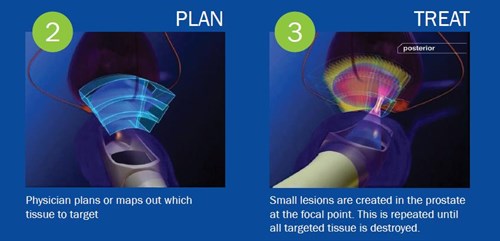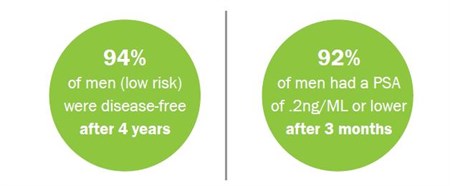HIFU (High Intensity Focused Ultrasound)
High Intensity Focused Ultrasound Prostate Ablation (HIFU) is a minimally
invasive treatment option for localized prostate cancer that is performed
on an outpatient basis.
While your cancer may continue to be well-managed with active surveillance,
some patients with early stage prostate cancer may benefit from treatment.
HIFU therapy is specific to each patient’s cancer. This allows the
physician to treat the areas of cancer exclusively – leaving the
areas of the prostate not involved with cancer untouched. This means less
risk of side effects such as urinary incontinence and erectile dysfunction,
which are associated with more invasive treatments, such as radiation
therapy or surgery.
About HIFU
High Intensity Focused Ultrasound (HIFU) uses ultrasound energy, or sound waves, to heat and destroy specifically targeted areas of cancerous tissue in the prostate. During HIFU, the sound waves pass through healthy tissue without causing damage. However, at the focal point of the sound waves the tissue temperature rises rapidly to 90 degrees Celsius, destroying the targeted tissue.
 The same principles are used when light is focused through a magnifying glass .
The same principles are used when light is focused through a magnifying glass .
With HIFU, physicians have the ability to target and treat a small amount of tissue, which minimizes damage to areas around the prostate. This helps preserve normal urinary function and minimizes risk of erectile dysfunction.
How HIFU Works
HIFU is a minimally invasive option that utilizes Sonablate® technology. The advanced computer-controlled HIFU delivery device transports the ultrasound energy through a probe placed in the rectum. These waves are then targeted directly at the prostate for accurate ablation and destruction of the diseased tissue.

The HIFU technology consists of a console where the physician plans, monitors and adjusts HIFU treatment, a transrectal probe and a chiller, which is a safety device that keeps the rectum cool during treatment.
The HIFU device uses an ultrasound with multiple sensors which allows the physician to both accurately treat and safely monitor the progress of the treatment simultaneously. Due to its accuracy and precision, areas around the prostate are undamaged, which greatly reduces the risk of side effects such as erectile dysfunction and urinary incontinence.
In select cases, HIFU can be used for focal treatment, which is selective treatment of the cancerous areas within the prostate alone, leaving the non-cancerous portions undisturbed.
HIFU prostate ablation is typically performed in an ambulatory surgery center under intravenous sedation. The radiation-free treatment is usually performed one time on an outpatient basis but can be repeated as necessary without causing adverse effects to surrounding tissues.
Benefits of HIFU
- Low risk of side effects such as erectile dysfunction and incontinence often associated with radiation therapy or surgery
- No damage to surrounding tissues or organs
- HIFU can be repeated, if necessary, without damaging healthy tissue
- One treatment with HIFU compared to multiple treatments sessions with radiation therapy/IMRT
- Outpatient procedure is typically performed in one to four hours.
- Radiation free
- No blood loss
- Quick recovery and return to normal activity within a few days
- HIFU does not preclude other treatment options; men who choose HIFU and then require additional therapies still have other treatment options available
- HIFU can be used as a prostate cancer salvage technique when other primary treatments such as radiation or cryotherapy fail
HIFU Outcomes

Candidates for HIFU include:
HIFU is most effective for men who have early stage, localized prostate cancer that has not spread or metastasized outside the prostate.
HIFU may also be an effective therapy for recurrent prostate cancer when patients may not have any other treatment options.
For men who are potential candidates for this treatment, your urologist will discuss the benefits and risks of HIFU, and whether this treatment option is right for you.
